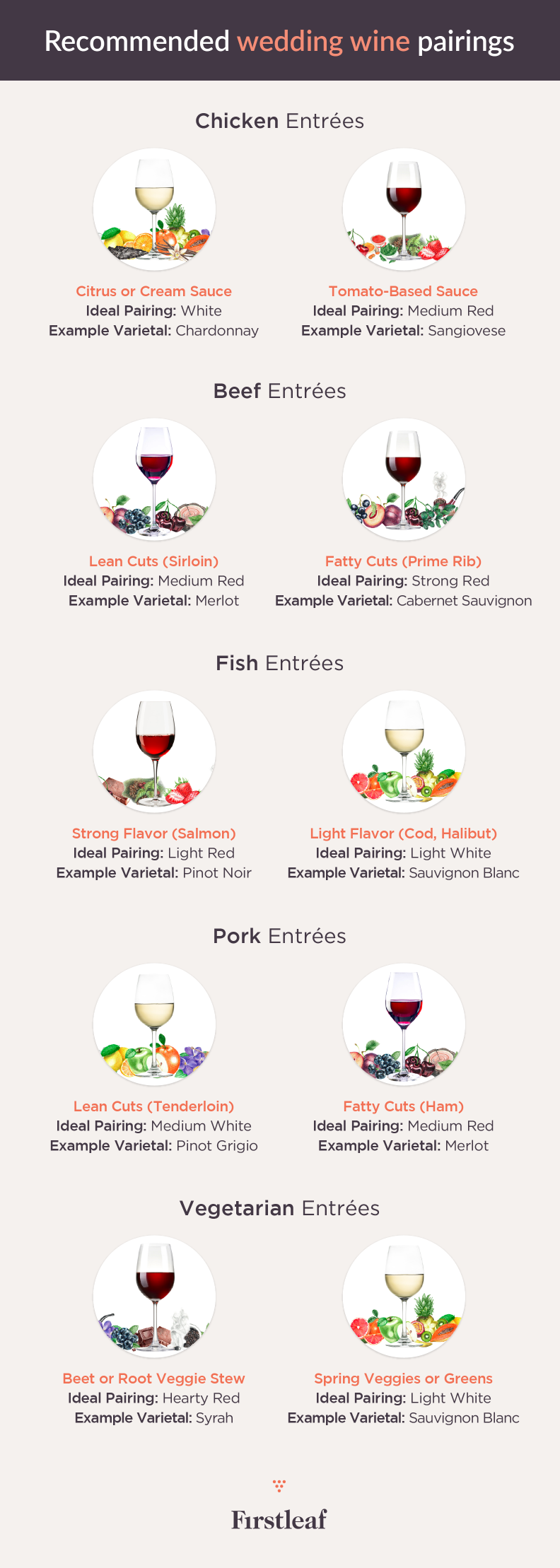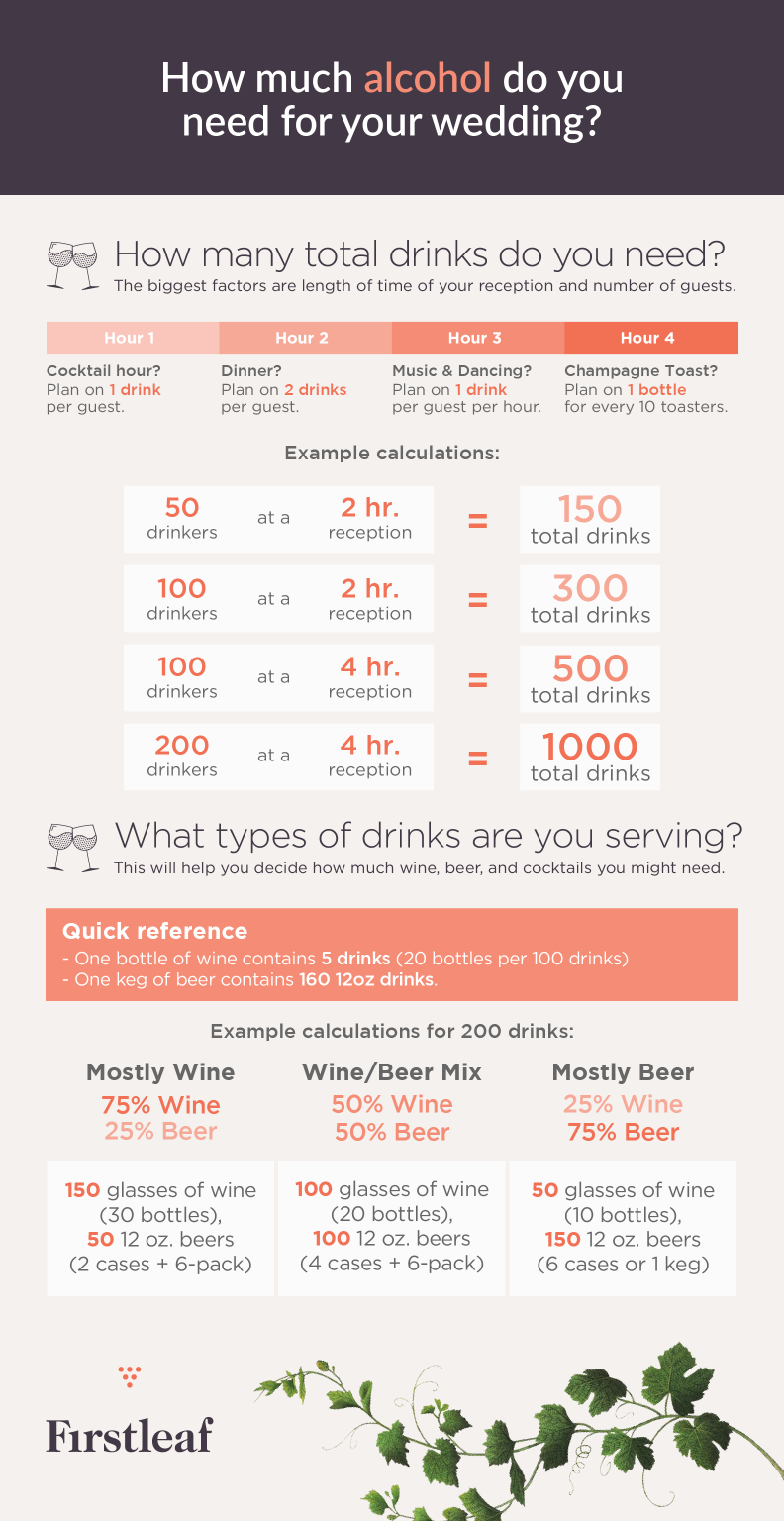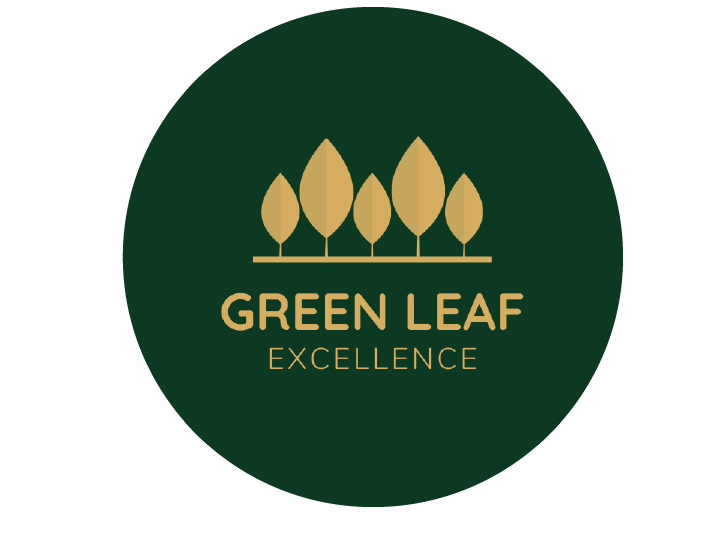How to Choose The Perfect Wedding Wine
Expert tips on how to pair wine with chicken, beef, pork, fish, or vegetarian entrees at your wedding. Plus formulas to help you decide how much wine to buy. There's a trick to choosing the perfect wedding wine: enjoying the process! You get to taste different varieties and wineries all in the name of "research."
Settle on a few wines you love, and you're sure to have guests snapping photos of the labels to buy for themselves later. Of course, there are some requirements - like pairing your picks with the right food and making sure you buy enough bottles.
This guide will answer all the technical questions you may have so you can get back to the fun part: Wine.
What makes a good wedding wine?
A good wedding wine pairs well with your reception meal and has the quality you’d want for such a special event while fitting within your budget.
How do you choose the perfect wedding wine?
The perfect wedding wine is something that can be enjoyed by novice wine drinkers and enthusiasts alike. At a large event like a wedding, the food flavors are typically a bit muted. Every table will have a picky eater or two, or someone who can’t handle spice. Similarly, a wedding isn’t the time to experiment with oddball pairings or exceptionally strong wines.
The exception would be a small, intimate ceremony of close friends and family. In this case, knowing the likes and dislikes of your limited group may make you free to experiment. A wedding wine will also pair with the main entree or entrees you are serving. If you are giving guests a choice of entree, you’d ideally give them a choice of wine as well.
One strong principle of wine pairing is place-specific food pairings. An entree featuring bright Mediterranean flavors like lemon should be paired with wine from that region, or one with a similar climate like Napa Valley. Likewise, an entree featuring beef should be paired with wine from a region where cattle are raised like Argentina or Eastern Washington.

Wedding wines - wine pairing
Chicken
The best wedding wine pairing with chicken depends on the flavors of your specific chicken dish. Serving chicken with a tomato-based sauce? A red wine from Italy could be a good choice. Another consideration is the mix of white and dark meat. If you are serving dark meat, which tends to have a deeper flavor, you might want to consider a wine with stronger flavors like a chardonnay. If you are serving only chicken breast, the lighter flavors of pinot grigio may be a better choice.
Beef
For the wedding couple that loves wine, beef is an excellent entree choice. Beef's deep, intense flavor calls for a full-flavored wine to match.
Cabernet Sauvignon is a classic pairing with beef, and one of the world's most popular varietals. If you decide to go with a cab sav you won't lack for options as nearly every wine-growing region offers one. By going with such a popular varietal, you could choose a wine from a place that has special meaning for the couple, making the choice even more perfect.
If you're looking for other options, consider this rule of thumb: the fattier the cut, the stronger the wine should be. Lean steaks like sirloin would benefit from a more subtle flavor. If you're having a fatty cut like prime rib, go bold.
Fish and Seafood
All fish are not created equal so the old "white wine with fish" rule isn't necessarily one to follow.
Fattier, stronger flavored fish like salmon or mahi-mahi pair well with lighter red wines such as pinot noir. If you do prefer a white wine with one of these stronger flavored fish, go for a stronger white, like a chardonnay. The sauce is a consideration as well. A stronger-flavored sauce, like teriyaki, might call for a stronger-flavored wine.
Mild fish like cod or halibut are best when paired with white wine. As with chicken, consider playing off the flavors that go along with the dish. Light Mediterranean flavors like lemon and herbs might call for a lighter wine like Sauvignon Blanc or Pinot Grigio. If a stronger flavor is being used, a stronger white like a riesling may be an option.
Pork
There's no hard and fast rule for pairing wine with pork. A hearty hunk of fatty smoked ham requires a totally different pairing strategy than a delicately flavored slice of lean pork tenderloin.
Still, pork is more delicately flavored than beef, and has hints of sweetness that a strong wine will overpower. Pairings for pork should occupy a middle ground. Medium-bodied red wines like merlot are as strong as you should consider for fattier cuts like ham or ribs. And for leaner cuts, don't go any lighter than a medium-bodied white such as pinot grigio.
Vegetarian Mains
The perfect pairing for a vegetarian main dish will match the heartiness of the wine with the heartiness of the vegetable. Seasonality is an important consideration as well.
Hopefully, you're able to use local, in-season vegetables -- which will help drive your choice. At a winter wedding, you'll probably want a warm, hearty wine. And root vegetables, an ideal pairing, will be the freshest ones available.
Consider a dish heavy in root vegetables like carrots, potatoes, and squash — or a deep-flavored bean stew. Sounds hearty, right? And both would be terrific with a popular red wine like cabernet sauvignon, merlot, or syrah.
If you're having a warm-weather wedding, delicate vegetables like local greens and in-season fruits would make for the best vegetarian main, and you'd probably want to stick with white wine. A salad with local fresh fruit would pair well with a wine with fruit notes to match like riesling.
Pair by Season
The time of year ought to play into both your choice of food and your choice of wine.
At fall or winter weddings, there's a good chance your guests will be coming in out of the cold, shedding their overcoats, and looking for a way to warm up. A hearty meal paired with a red wine like a syrah or tempranillo will brighten their mood. A light salad and a fruity white wine may not have the same effect.
Spring is a temperate time of year, and a good time to sample wines from the warmer growing regions. Areas like California, Australia, and Spain enjoy a perpetual spring, and produce bright wines to match.
If you're having an indoor summer wedding with the benefit of air conditioning, your food choices should drive your wine selection choices.
For an outdoor summer wedding, you should keep in mind that your guests are likely to be hot. A wine that can be chilled -- white, rose, or sparkling -- is an easy choice for sipping during the whole reception.
But for the food service (depending on your main course) you may want to have something bolder on hand. If you're serving steak, you'll want some full-bodied reds like cabernet sauvignon or merlot to pair.
Pair by Wedding Theme
If your food is part of the wedding theme, your wine should be too. A beach-themed wedding with fresh fruit and seafood on the menu can benefit from wine with tropical notes, often found in white wines like chardonnay or sauvignon blanc.
Centering the theme around the honeymoon spot is a popular option, and as long as you're not honeymooning near the Arctic Circle, there's probably a wine made nearby that would enhance the theme.
If your theme is creative, get creative with your wine, too. There are thousands of wines with some very unique names, pick one that goes with your theme.
What are some popular wedding wines?
Popular red wedding wines are cabernet sauvignon, pinot noir, and rose. Popular white wedding wines are chardonnay, sauvignon blanc, and pinot grigio. Popular sparkling wines for weddings are champagne, sparkling rose, and prosecco.
When choosing wine for your wedding reception, you should aim for a wine that is not too complex or bold, to ensure that all guests can enjoy it.
How much wine should you buy for a wedding?
The amount of wine you should buy for your wedding depends on several factors.
Number of guests attending (and also drinking)
Duration of the wedding/reception
Whether you are serving other alcoholic beverages
To start with, figure out how many alcoholic beverages you'll need overall. The basic rule of thumb for any celebration is 2 drinks per person for the first hour, and 1 drink per person for every hour thereafter.
So, if you were having a 4-hour reception for 100 adults, you could expect to serve 200 drinks in the first hour, and a further 100 drinks each in hours 2, 3, and 4: 500 drinks.
Of course, you may have reasons to adjust that estimate. If your reception is in the middle of the day rather than the evening, you can expect people to drink a little less. And if you know that a certain portion of the guest list doesn't drink at all, you can bring your estimate down (of course, you'll want to provide them with non-alcoholic options).
How much wine should you buy if you're only serving wine?
If you're only serving wine, figure on about a bottle per person for a longer event (four hours or more).
How do you choose a mix of red and white?
Choose the mix of red and white based on the time of year, and the food you're planning to serve. A light meal of chicken during a summer outdoor wedding? You might almost exclusively select white wines. Serving prime rib in the middle of winter? Going red-heavy would make more sense.
How much wine should you buy if you're also serving beer?
If you're also serving beer at your wedding, figure on about 1 bottle of wine for every 2 guests for a longer event (four hours or more). People will likely enjoy beer before dinner, then switch to wine with their meal. You should have at least enough for everyone to have two glasses of wine with dinner.
How much wine should you buy if you're serving beer and cocktails?
If you're serving beer, wine, and cocktails at your wedding, providing 1 bottle of wine for every 4 guests should be sufficient. This will provide enough wine for everyone to enjoy a glass with dinner and some overage for those who prefer wine above all else.
How many glasses of wine in a bottle?
A normal 750 milliliter bottle of wine has five glasses of wine. A case of wine contains 12 bottles, or approximately 60 glasses of wine.

Wedding Wine - Alcohol Calculator
Example: How many bottles of wine do you need for 100 guests?
Let's take a real-world example: A 100-adult reception, including a cocktail hour, dinner, and dancing, lasting approximately four hours.
How many guests will be drinking?
Let's say that you know for a fact that 15 people on the guest list don't drink. That takes our number of drinking guests down to 85.
Based on the guidelines above, 85 drinkers at a 4-hour party can be expected to drink 2 drinks per person in the first hour, and 1 drink every hour thereafter. So we'll be serving
170 drinks (2 x 85) during hour 1, and
255 drinks (3 x 85) during hours 2, 3, and 4 (1 per person per hour)
The total number of drinks we need to provide is 170 + 255 or 425 drinks.
Are you serving other drinks?
Let's say we also plan to offer a specialty cocktail, and, because our guests are big beer fans, purchase two different kegs of beer. We should assume 1 cocktail per person, so that's 85 drinks. A 15.5-gallon keg contains 124 pints of beer for a total of 248. Between our specialty cocktail and our beer, we've taken care of 333 drinks.
That would leave us with 92 drinks to come from wine or about 18 bottles of wine.
Are you serving a meal?
If you're serving a meal, especially a sit-down meal with a thoughtfully-considered wine pairing, you may want to assume that guests will drink at least two glasses while they eat. So, in the case of our example, even though our calculator tells us that we only need 92 drinks of wine, we may want to stock enough for everyone to have those two glasses, and plan on 170 glasses of wine or 34 bottles.
Is your wedding in the afternoon or evening?
People tend to drink less at afternoon events than during evening events. At a lunch reception, one glass of wine with the meal is probably all that most people will want. So we might revise our wine estimate down to 85 drinks (1 per person) or 17 bottles of wine.
How many bottles of champagne do you need for a toast?
Champagne and other sparkling wines are sold in 750-milliliter bottles just like regular wine. And just like regular wine, you can count on approximately 5 full glasses of wine per bottle.
But you don't need or want a full pour for a champagne toast -- only enough for a sip or two. A light pour, approximately halfway, is all that's needed. So, for a champagne toast, you'll need about 1 bottle for every 10 drinking guests. For a 100-person event that would mean 10 bottles of sparkling wine.
Start Sampling Wedding Wines Now
Everything about this special day should be about you. The more personal it is, the more fun and memorable it will be for everyone else.
One good way to make a wedding day your own is to select wines that you have sampled and enjoyed. If you aren't sure where to start, you could go to a tasting at a local wine shop, visit a local winery, or consider a wine club subscription like Firstleaf. We have a rating system that lets you zero in on the wines that you enjoy most -- and that you'd want to share with all the special people on your special day.







